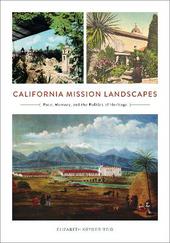
|
California Mission Landscapes: Race, Memory, and the Politics of Heritage
Paperback / softback
Main Details
| Title |
California Mission Landscapes: Race, Memory, and the Politics of Heritage
|
| Authors and Contributors |
By (author) Elizabeth Kryder-Reid
|
| Series | Architecture, Landscape and Amer Culture |
|---|
| Physical Properties |
| Format:Paperback / softback | | Pages:368 | | Dimensions(mm): Height 254,Width 178 |
|
| Category/Genre | Landscape art and architecture
History of architecture
Local history |
|---|
| ISBN/Barcode |
9780816637973
|
| Classifications | Dewey:979.4 |
|---|
| Audience | | General | | Professional & Vocational | |
|---|
| Illustrations |
139
|
|
Publishing Details |
| Publisher |
University of Minnesota Press
|
| Imprint |
University of Minnesota Press
|
| Publication Date |
30 November 2016 |
| Publication Country |
United States
|
Description
Nothing defines California and our nation s heritage as significantly or emotionally, says the California Mission Foundation, as do the twenty-one missions that were founded along the coast from San Diego to Sonoma. Indeed, the missions collectively represent the state s most iconic tourist destinations and are touchstones for interpreting its history.
Author Biography
Elizabeth Kryder-Reid is professor of anthropology and museum studies and director of the Cultural Heritage Research Center in the Indiana University School of Liberal Arts (IUPUI) and former director of the IUPUI Museum Studies Program.
Reviews"California's Spanish-Mexican missions are among the least known of America's significant historic sites. Elizabeth Kryder-Reid's pioneering study of the missions' gardens uncovers their roles as sites of forced labor, romantic nationalism, racial formation, indigenous experience, and religious devotion. Her eye-opening account illuminates the tangled origins and meanings of these gardens, respecting the complexity that makes them so fascinating."-Dell Upton, author of Another City: Urban Life and Urban Spaces in the New American Republic "This book must be read to understand the cultural memory presented in the landscape of the California missions. Rather than true to the missions' actual look and to the history of land use, the gardens create an imagined past and an aestheticized space. Elizabeth Kryder-Reid examines the creation of the celebratory narrative the missions acquired through their landscapes. Her exemplary study makes it possible to also envision them as de-colonial sites."-Lisbeth Haas, author of Saints and Citizens: Indigenous History of Colonial Missions and Mexican California "Out here in California, we're taught in elementary school that missions set up by Catholic missionaries during the Spanish era were necessary to save the Indians; in college, we're rightfully taught they were basically concentration camps. This University of Minnesota Press libro is of the latter school, but takes on the fascinating prism of gardens to tell its enrapturing narrative."-Monterey County Weekly "A case study for discussing the politics of memory for heritage sites worldwide, making it an appropriate addition for any art library."-ARLIS/NA Reviews "Kryder-Reid's strengths lie with her detailed interrogation of mission gardens, and California mission heritage more broadly, as well as her ability to foster dialogue about colonialism and the formation of cultural memory."-Western Historical Quarterly "Poignant and timely... More importantly, it is a counter narrative that needs to be told."-News from Native California "The book's greatest strength is in reinforcing the idea of landscape as text. It is well written and reflect solid research."-Historical Geography "Using landscape as a starting point, Kryder-Reid marshals a truly impressive array of evidence to show how the California missions have been remade over time and to imagine what the future might hold for these historically and emotionally resonant places."-The Journal of Colonialism and Colonial History "The book succeeds as a primer for those interested in the ways California's missions have been interpreted to date. Further, it successfully discusses how future interpretive plans that allow for meaningful conversations to take place at sites with difficult, contested histories might be envisioned."-New Mexico Historical Review
|